(Mark Paricio is a PolarTREC Teacher accompanying the Polaris Project this summer. To read all of Mark’s journals, go to: http://www.polartrec.com/expeditions/siberian-arctic-systems-study )
Mt. Rodinka, a small mountain (351 m) rises from essentially sea level east of the Northeast Science Station. It sits in front of a many higher and larger mountains in the distance. Rodinka, I have been told means either “Birthmark” or “Little Mother Earth” in Russian. On a topographic map, it does have a distinctive “C” shape, but I prefer to think of it as the latter definition.
When I am in unfamiliar territory, the first thing I like to do is climb to a high vantage point to get the lay of the land. Today, I had that opportunity AND got to take soil samples on top!
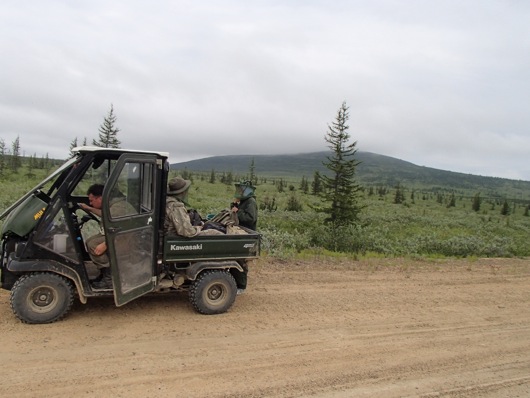
My companions to Rodinka were Dr. Sasha Kholodov, Dr. Valentin Spektor, and Varvara Andreeva – my drilling team.
Yedoma
Yedoma (or “Edoma” in Russian) is the term for the particular permafrost in northern Siberia. Its composition from ancient sediments, though varied locally, is similar throughout the thousands of miles it covers. But where did those sediments come from? It makes sense to look at the mountains up river for the source these 10,000 to 40,000 year old soils. In one way, this is how Rodinka could truly be considered to be a “little mother earth” – a source of the soil on which thousands of thousands of years of vegetation and fauna have depended.
After driving in our ATV truck for half an hour on dirt roads warped by frost heaves, we reached the base of Mt. Rodinka and hiked to the rounded and virtually treeless summit. Once on top, we took in the vistas for a couple of minutes and started sampling. Valentine and Varvara, ever diligent, made detailed descriptions of each sample location in their field notebooks. Valentine’s plan is to compare the composition of the soils on top of Rodinka with the permafrost layers we drilled below.
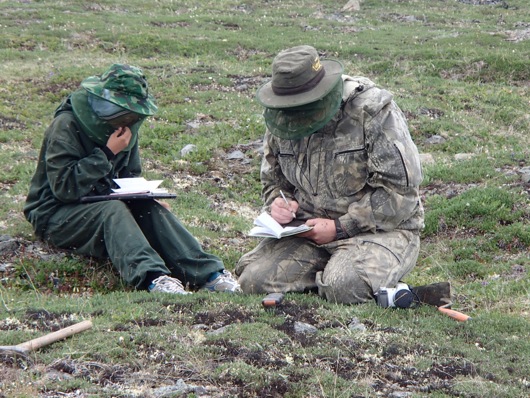
Valentine and Varvara, ever diligent, made detailed descriptions of each sample and location in their field notebooks.
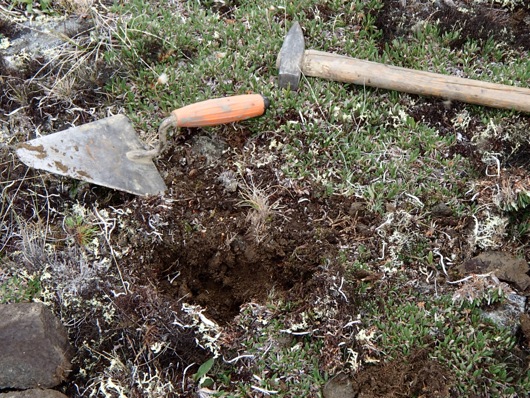
The trowel and hammer give scale to one of the soil sampling sites. Valentin first removed a small rock and dug below to get an undisturbed sample.
You’re Never Down until You’re Down!
There’s an axiom among mountaineers that going up is only half the climb. We still needed to get back to the science station. Unfortunately, our ATV had other plans, and we had some mechanical issues on the way down. (If you look hard at the top picture, you’ll see the front hood of the ATV open.)
Fortunately, we had cell phone coverage from that location and were able to call for a little help from the science station mechanic, also named Sasha. Between the mechanic Sasha and Dr. Sasha Kholodov’s efforts, we were able to limp back to the station, towing the ATV the last few kilometers. Between drilling and ATV engines, I have decided that the mechanic is one of the most important people at the Northeast Science Station! It is also critical for field scientists to be as mechanical as possible if they wish to reach truly remote locations. I know that the members of the aquatic survey have encountered similar problems with their outboard motors, but have had sufficient resources and communications to deal with theses issues, as well.
I Never Thought I Would Reach a Summit in Siberia!
The hike up Rodinka was a pleasant stroll in terms of alpine adventures – except that it was in Russia. I truly enjoyed the opportunity to view the Siberian Arctic System from this vantage point.
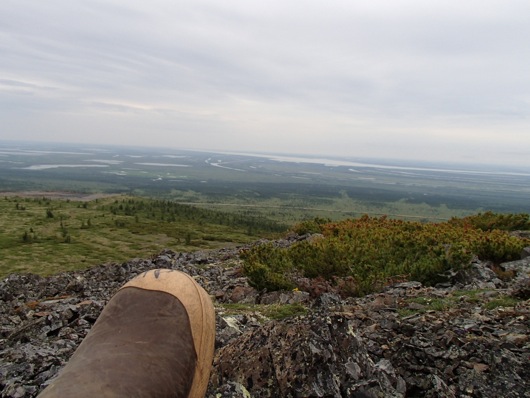
My left boot in front of the view down to the Kolyma River from near the summit of Rodinka. See my PolarTREC journal of May 27 to see the last mountain my left boot hiked.
You never know where opportunities will lead if you embrace them! I am grateful to the Polaris Project and PolarTREC for this opportunity to see field science in Siberia.
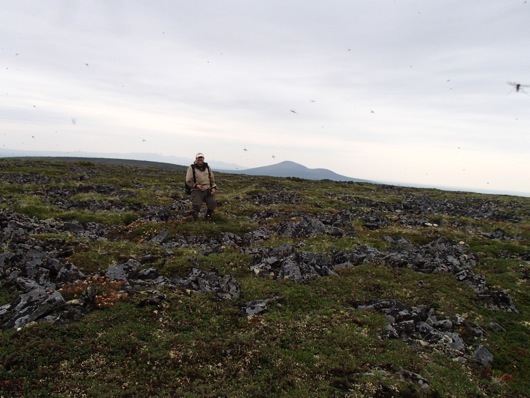
Mark savors reaching the summit of Rodinka, despite the mosquitoes! Photo by Varvara Andreeva.
Stay curious my friends! – Mark Paricio



